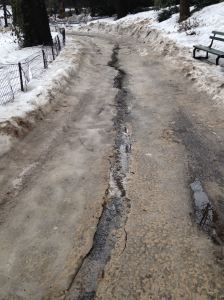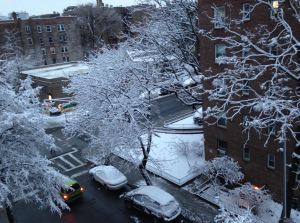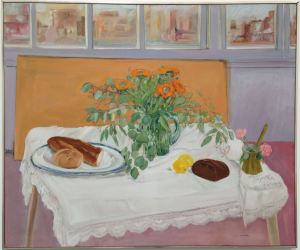“Memories are motionless, and the more securely they are fixed in space, the sounder they are.” – Gaston Bachelard, The Poetics of Space

Earlier today, taking a break from painting, I googled studio prices in NYC to check out the going rate. The above studio is on the market in Tribeca. For 300 sq. ft. you will pay $1875.00/month!
Once upon a time, I rented a painting studio of my own. The space was larger than the the space above. For 400 sq. ft. I paid $400.00/month. Situated above a clock store in Williston Park on Long Island, a decidedly unhip but affordable and convenient location at the time, northern light flooded my studio all day long. I was in heaven.
Excited to have a dedicated workspace I could get as dirty as I wanted, I laid down a roll of cheap linoleum, moved in my work table and supplies and got to work.
One morning as I arrived, the proprietor of the store below me was standing amidst a forest of chiming grandfather clocks, front door open. He introduced himself right away and asked me what I was up to, mentioning he always heard music playing. He then said he enjoyed (rather than objected to) the music and seemed a bit tickled to find out that someone was making art in the space above him instead of preparing tax returns or teaching traffic school.
I fondly recalled my studio days as I stepped back from the easel this afternoon to assess the progress of a new painting. My studio is the second bedroom of the two bedroom apartment we rent in Queens. I never did put down linoleum, but I guess I should have.
It’s fun to fantasize about the days when I painted full time as I spend my days off from a dreadful office job. I’m not complaining, per se, but occasionally on days like these I enjoy torturing myself by thumbing through an artist book I own called Studios by the Sea.
To refer back to Bachelard in Poetics of Space, he writes: “…even when we no longer have a garret, when the attic room is lost and gone, there remains the fact that we once loved a garret, once lived in an attic. We return to them in our night dreams.”
This is so true. At heart, I’m a romantic. A big part of me loves to dream and yearn. Loves the yearning part more than the actual getting. The aroma of coffee beans in the grinder more delicious than drinking the brew. As I flipped through Studios by the Sea I wished and imagined. Sometimes walking around NYC, I will find myself gazing longingly at a 19th century townhouse on the Upper East Side — yearning to live there. And enjoying every minute of yearning.
During my recovery from a broken ankle last summer, I would pass a particular townhouse on East 63rd St. on the way to physical therapy. A painting hanging on the wall by artist Caio Fonseca was visible through the expansive front window. It held my eye each time I passed by. His work is a favorite of mine. As I stopped to gaze, I conjured an entire fantasy scenario based upon seeing his work hanging in that space. On the landing beneath the painting an elegant ebony grand piano, keyboard exposed, was poised to be played. Above hung a glittering crystal chandelier. Aware Fonseca played the piano, I was convinced it was a Steinway and that Fonseca lived in the townhouse.
But he didn’t live in the townhouse as I would come to find out. The scene – his painting, the piano, the splendor of the decor – had been staged by a real estate agent, likely another “romantic” like myself. That agent, through his or her design, had gifted me many evenings of yearning and pleasurable wanderings.
Fantasy is better than the reality. I suppose people who invest in their “dream house” spend the rest of their lives “making it even better than they imagined” with continual remodeling because intrinsically they know that dreams are never realized. Otherwise, they would no longer be dreams.
…the house shelters daydreaming, the house protects the dreamer, the house allows one to dream in peace.” – Bachelard





























